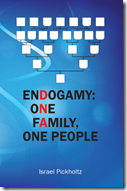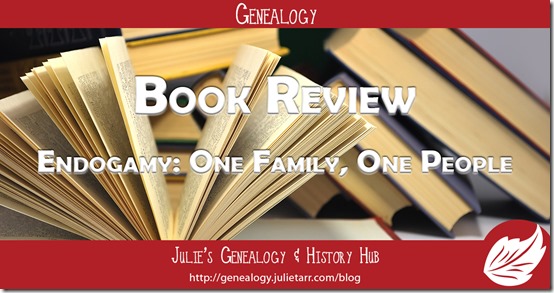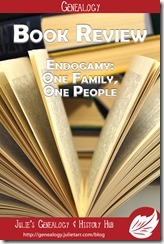 Title: Endogamy: One Family, One People
Title: Endogamy: One Family, One People
Author: Israel Pickholtz
Format: Paperback
Published: 2015
My Rating: ![]()
![]()
![]()
![]()
The following review first appeared in the Federation of Genealogical Societies FORUM magazine (Fall 2015); reprinted with permission.
The world of genetic genealogy has grown considerably over the last several years. The testing of one’s DNA and comparing the results to others has no doubt crumbled a few brick walls. As more and more people test their DNA, resources that help navigate the DNA pool are in high demand. Many of the top genetic genealogists are doing their part to provide blogs, articles, and lectures geared toward helping people interpret results and understand how to use the various tools available.
One area of genetic genealogy that is difficult to write or lecture about relates to endogamous populations in which marriage among close cousins is so common that it could mean multiple relationships among descendants. While this phenomenon is particularly relevant to those with Jewish ancestry, there are many instances where endogamous populations exist. Endogamy is not necessarily an issue for traditional genealogy research, but when DNA is involved, those multiple relationships can affect how the results are calculated and interpreted.
Knowing that a lack of resources exist for working with DNA in endogamous populations, Israel Pickholtz drew on his own experience with genetic genealogy and his Jewish roots to compile Endogamy: One Family, One People, which outlines how he has navigated the DNA waters thus far in his journey. The focus of this book is mainly on Pickholtz’s Jewish roots, however many of the techniques are useful for other endogamous populations, as well as genetic genealogy in general. Those who participate in or manage surname studies, might also find the practices in this book helpful.
Because this book is about one man’s quest, where several cases are presented that relate to his own family, you will find very quickly that this is not a “how-to” book. Instead, it’s like reading various case studies presented in genealogical periodicals such as National Genealogical Society Quarterly and The American Genealogist, and taking those lessons learned and applying them to your own research problems. As Pickholtz describes in his introduction: “I am here to inspire you, to show you what can be done, to encourage you to say ‘I can do this.’”
This book certainly lives up to the author’s expectation, and my own. While I do not have Jewish ancestry, I am working on an adoption case using DNA and learned through the testing that the adoptee’s paternal line comes from an endogamous population in North Carolina. Endogamy helped me to understand the DNA results with this phenomenon in mind and introduced me to several techniques that may be helpful in sorting through all the clutter. Outside of this case, there are many practical tips that I plan to utilize while working with the DNA results for my own family.
Pickholtz begins the book with a substantial introduction explaining how he came upon his genealogical journey. This endeavor then progressed to the “Pikholz Project” after corresponding with other relatives. In a quest to determine if different Pickholtz branches were connected, the author turned to genetic genealogy.
The author then moves on to “Chapter 0,” where he discusses the basics of DNA testing as it relates to genealogy. While he states in the first paragraph that “the more experienced” can skip ahead, I caution you not to skip the whole chapter, as on pages 5 and 6 he describes the concept of endogamy in relation to DNA in a section titled “When Cousins Marry.”
The remainder of the book is essentially a series of case studies. Again, Pickholtz presents several different cases throughout this book, exhibiting different scenarios using both DNA testing and traditional research. Each time, he thoroughly explains the problem and/or hypothesis, the steps he took to explore the possibilities, and how he reached his conclusion (or, in some cases, plans for additional research and DNA testing). There are plenty of illustrations and tables to help emphasize the points and data analysis.
The cases discussed are all very interesting and enlightening, but one of the best parts of this book is the exploration of GEDmatch’s Lazarus tool, which can essentially build a genome for deceased relatives. I have read about Lazarus and added it to my list of tools to explore further. But, Pickholtz’s examination of the tool and how he used the information to further his DNA research made me want to put the book down and head straight to the computer and get started. Pickholtz really shows what the Lazarus tool can do and this alone is reason enough to check out this book.
Pickholtz wraps up the main chapters with a discussion of the X chromosome. The book concludes with “A Stopping Place,” where the author shares future plans, a wish list, and final thoughts for the reader.
Overall, Endogamy is a resource that anyone studying endogamous populations through DNA testing should pick up. Anyone who is serious about their genetic genealogy research will also benefit from this book, even if endogamy is not an obstacle. Pickholtz has put together a treasure filled with case studies, lessons learned, and wisdom from which all of us can benefit.



Share your thoughts...